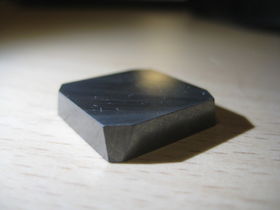Difference between revisions of "Tungsten carbide"
(→Physical) |
|||
| (2 intermediate revisions by 2 users not shown) | |||
| Line 8: | Line 8: | ||
| OtherNames = Tungsten(IV) carbide<br>Tungsten tetracarbide | | OtherNames = Tungsten(IV) carbide<br>Tungsten tetracarbide | ||
<!-- Images --> | <!-- Images --> | ||
| − | | ImageFile = | + | | ImageFile = Tungsten_carbide.jpg |
| − | | ImageSize = | + | | ImageSize = 280px |
| ImageAlt = | | ImageAlt = | ||
| ImageName = | | ImageName = | ||
| Line 142: | Line 142: | ||
*Catalyst | *Catalyst | ||
*Tungsten carbide crucible for single crystal growth | *Tungsten carbide crucible for single crystal growth | ||
| + | *Scratch glass | ||
==Handling== | ==Handling== | ||
| Line 164: | Line 165: | ||
[[Category:Insoluble compounds]] | [[Category:Insoluble compounds]] | ||
[[Category:Readily available chemicals]] | [[Category:Readily available chemicals]] | ||
| + | [[Category:Ceramic materials]] | ||
| + | [[Category:Superhard materials]] | ||
Latest revision as of 14:46, 23 December 2021
 |
This article is a stub. Please help Sciencemadness Wiki by expanding it, adding pictures, and improving existing text.
|

| |
| Names | |
|---|---|
| IUPAC name
Tungsten carbide
| |
| Other names
Tungsten(IV) carbide
Tungsten tetracarbide | |
| Properties | |
| WC | |
| Molar mass | 195.85 g/mol |
| Appearance | Grey-black lustrous solid |
| Odor | Odorless |
| Density | 15.6 g/cm3 |
| Melting point | 2,785–2,830 °C (5,045–5,126 °F; 3,058–3,103 K) |
| Boiling point | 6,000 °C (10,830 °F; 6,270 K) |
| Insoluble | |
| Solubility | Insoluble in organic solvents |
| Vapor pressure | ~0 mmHg |
| Thermochemistry | |
| Std molar
entropy (S |
32.1 J·mol-1·K-1 |
| Hazards | |
| Safety data sheet | Sigma-Aldrich |
| Related compounds | |
| Related compounds
|
Tantalum carbide Titanium carbide |
| Except where otherwise noted, data are given for materials in their standard state (at 25 °C [77 °F], 100 kPa). | |
| Infobox references | |
Tungsten carbide is an inorganic compound of tungsten and carbon, with a chemical formula WC (the most common type) or W2C.
The term "Widia" is also used for tungsten carbide items.
Contents
Properties
Chemical
Tungsten carbide is a very inert compound, most of the acids don't attack it except a mixture of HF /HNO3 above room temperature. It reacts with fluorine at room temperature, with chlorine at 400 °C (752 °F) and with hydrogen at its melting point.
When ground to a fine powder, it readily reacts in aqueous solutions of hydrogen peroxide.
Physical
Tungsten carbide is a hard, brittle grey-black solid, insoluble in any solvents and has good chemical resistance. It has a melting point of 2,870 °C (5,200 °F) and a boiling point of 6,000 °C (10,830 °F). Its hardness on the Mohs scale is 9. Tungsten carbine is also an electrical conductor.
Availability
Tungsten carbide can be found in many cutting tools, though it's not pure, it contains cobalt or nickel that serve as a binder.
Certain weights also contain tungsten carbide.
Rotating balls in ballpoint pens are made out of tungsten carbide or its alloy, though their small size means they're not a good source.
It is also used as a metal-like material in jewelry.
Tungsten carbide powder can be bought online.
Preparation
WC can be prepared by reaction of tungsten metal and carbon at 1400–2000 °C.
It can also be produced by heating WO3 with graphite: directly at 900 °C or in hydrogen at 670 °C following by carburization in Ar at 1000 °C.
Projects
- Make elemental tungsten
- Catalyst
- Tungsten carbide crucible for single crystal growth
- Scratch glass
Handling
Safety
Tungsten carbide isn't very toxic, but inhalation of its dust can lead to fibrosis.
Storage
No precautions needed.
Disposal
It can sometimes contain small amounts of heavy metals like cobalt, so it shouldn't be thrown readily.